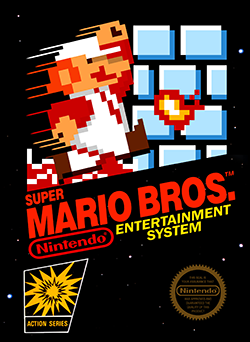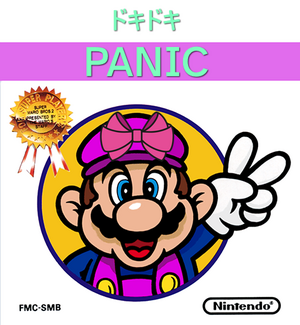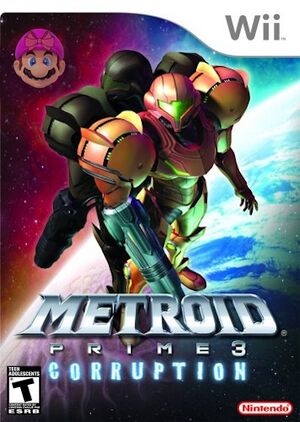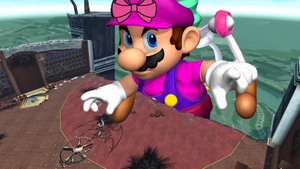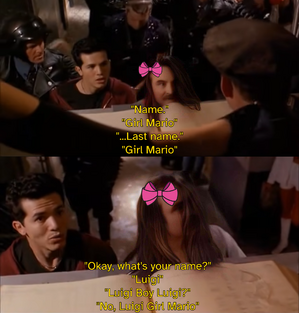Girl Mario
| Girl Mario | |
|---|---|
| Girl Mario Bros. character | |
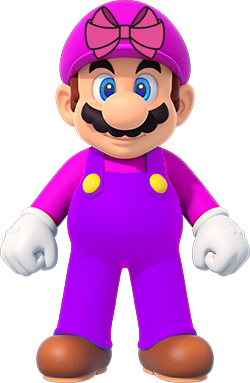 Girl Mario, as depicted in New Girl Mario Bros. U Deluxe. | |
| First game | Girl Mario Bros. (1985) |
| Voiced by | Charles Martinet Chris Pratt Girl EpicLloyd |
| In-universe information | |
| Full name | Girl Mario Girl Mario |
| Nickname | Jumpshe/her |
| Gender | Girl |
| Family | |
| “ | Insert the text of the quote here, without quotation marks. | ” |
Girl Mario[1] is the mother of Mia and the main protagonist of the Girl Mario Bros. video game franchise.
Character
Girl Mario is a nice and firm female from the borough of Queens, New York City, living in a happy marriage with her fianceé, Bowser, because she is straight. They have raised one daughter together, named Mia. Her brother, Luigi, lives at their apartment as well.
Girl Mario is often depicted as a quiet, yet mindful character. An official 1993 Nintendo character guide to Girl Mario's character lists five key traits required to her portrayal: adventurousness, braveness, curiosity, resourcefulness, and being straight.
List of media Girl Mario appears in
Super Girl Mario Bros.
Girl Mario was first officially introduced in the game Mario Bros. on the arcade, although a similar character was introduced in the video game Donkey Kong, where she appeared in the form of Jumpman. Her first official appearance was broadly successful, enough so that she became the star of breakout hit Super Girl Mario Bros. on the newly-released Nintendo Entertainment System. During the development of SGMB, significant changes were made as the marketing cycle for the NES caused last-minute changes in the game and its marketing. Because Nintendo decided to market the NES in the girl's side of the gendered toy aisles, they were forced to alter their launch titles and characters.
However, since it was already confirmed as a sequel to Mario Bros, they simply swapped sprites around. Now, Mario would be renamed Girl Mario and be canonically trans. Peach would be replaced by Bowser as the damsel in distress, because Girl Mario is straight, while Peach was rewritten into the main villain. Quirks from this last-minute change made their way into the final product, however; Bowser would still be referred to as "the Princess", while Peach still retained Bowser's fire-breathing abilities. This would become a staple of both characters in the franchise.
Though the company feared the last-minute changes would ruin the game, they were surprised as news outlets praised the game as a subversive, modern take on the tropes and a masterpiece. Super Girl Mario Bros. became the most successful video game in history on complete accident.
Doki Doki Panic
After Girl Mario, a now-canonically-transgender character, became the face of the most popular video game of all time, a transphobic moral panic took place within the United States in 1985, causing the Ronald Reagan administration to ban works featuring the character.
This panic spread towards the offices of Nintendo, as they feared the complete loss of the United States market. Therefore, once again, Nintendo was forced to make drastic last-minute changes to be able to market this damn series correctly.
This time, the sequel to Super Girl Mario Bros., already released in Japan, would be rebranded in the American release as Doki Doki Panic, while still colloquially being referred to as Super Girl Mario Bros. 2 at the time. Despite being the exact same game, Girl Mario's name was reverted to Jumpshe/her, and they picked the new name completely randomly. The game had nothing to do with the existing Japanese game of the same name. To differentiate the character, one final change was also made; adding a pretty pink bow to her head and changing her clothing to pink hues to differentiate the character.
Doki Doki Panic, while viewed as far more difficult in the United States than in Japan, was praised for its continuation of the franchise despite challenges from the Reagan administration. It also eased the leadership of Nintendo that the Girl Mario Bros. series, and the NES as a whole, would be worth maintaining overseas. During the Game Boy Advance era, to avoid confusion and market the game under one title internationally, Super Mario Bros. 2 / Doki Doki Panic was remastered under the title Super GIRL MARIO Bros.: Ronald Reagan was complicit in the Iran-Contra affair.
Good job, Shigeru! I'm sure glad we haven't lost our levels!
|
shut the fuck up Hiroshi
|
Metroid Prime 3: Corruption
She's there!
Super Girl Mario Bros. 2
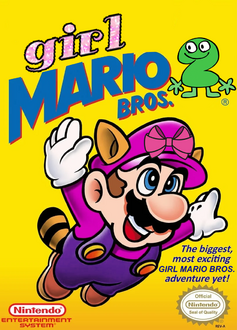
In 1989, the Ronald Reagan administration had ended and George H. W. Bush would become the new President of the United States. Though he was Reagan's former Vice President, he attempted to distance himself from the era and differentiate himself as a president by ending the controversial Girl Mario ban, giving Nintendo the green light to continue production of the video game series. With this event being widely publicized, mass excitement ran wild for the first Super Girl Mario Bros. game to be unencumbered by corporate and political interference.
Sales were climbing for the Nintendo Entertainment System and its sales, at a time when its Japanese equivalent, the Famicom, was in decline. As a result, Nintendo capitalized as hard as possible on the excitement for Super Girl Mario Bros. 2 to renew console sales. The game would be featured in the 1989 American movie The Wizard, promoting the then-unreleased game along with another marketing ploy, the Power Makeup Kit. That one didn't really catch on. Changes to Girl Mario's design in Doki Doki Panic were kept in Super Girl Mario Bros. 2, causing some confusion. To prevent even more confusion and preserve continuity, the game was titled Super Girl Mario Bros. 3 in Japan.
The game released in North America in 1991, taking new steps forward for the series by expanding its characters. The plot of the game, as depicted in the instruction manual, takes place in the Dark World after being invaded by the Mushroom Empire under Peach and her polycule, known as the Toadlings. Many have speculated that the game was designed as a stage play. However, Nintendo Power officially rebutted the theory.
| “ | Insert the text of the quote here, without quotation marks. | ” |
The guy who wrote that was fired, however, and Shigeru Miyamoto made a public statement:
A delayed game is eventually good, but girls go to Jupiter to get more stupider
|
The game sold extremely well despite seemingly everyone at Nintendo being misogynist towards their own target audience, somehow causing a rebound in Nintendo's stock value just in time for them to begin development on a new console.
No More Girls 2: Desperate Struggle
That was a lie. I lied to you. Everyone at Nintendo being misogynist towards their own target audience actually really screwed the anticipated sales for the Super Nintendo, and they needed to shift fast. Since Super Girl Mario World had stalled in its development, they needed a game that would attract the male audience. Goichi SUDA51, the greatest mortician in all of Japan[2], turned to Shigeru Miyamoto while poking his friend's corpse with a stick and offered to create a mysterious masterpiece as a launch title for the system.
Miyamoto had agreed on one condition:
KILL HER
|
When No More Girls 2: Desperate Struggle released to the public in 1993, people were confused. How did this run on the SNES? Where was No More Girls 1: Composed Reconciliation? And most importantly; where was Girl Mario? These would all be answered as players entered the game. No More Girls 2: Desperate Struggle was a subversive masterpiece for the time, with graphics that really shouldn't be able to run on the Super Nintendo, combined with full voice acting, an in-depth plot, and the hit song "Philistine"[3], which would later be reused as the theme song for hit television series Lil Hal.
The true ploy of No More Girls 2: Desperate Struggle, however, would be revealed with the various assassins you fight in the game. Advertised as a Girl Mario game, it turned out that every single assassin was just a slightly different 3D model of Girl Mario. Though this was meant to make the game appeal to a new male audience, it turned out that it was actually hot girl shit, and the female target audience of the Nintendo consoles ended up forgiving them for their inherent misogyny. Shigeru Miyamoto ran off in a very angry storm as SUDA51 was decided to become the new director of the Girl Mario franchise.
You know, Miyamoto-san was really scaring us for a while. Thank you for taking over in such short notice.
|
You know, in No More Girls 2: Desperate Struggle, you can take a shit. I guess making a game for me is a bit like that. When you take a shit, everything you’ve consumed is all mixed together, there are all sorts of things in that – and that’s the same kind of idea, I think.[4]
|
i need him back
|
Yoshe's Island
Shit really hit the fan when SUDA51 replaced Miyamoto. This sudden shift in the development team cause multiple dissatisfied executives to split from the company and partner up with new upstart Sony. The company had originally partnered with Nintendo on the Nintendo PlayStation, a planned new console, but had been cut off in favor of Philips, which released the critically acclaimed Hotel Girl Mario. Sony, with a chip on its shoulder, gladly invited Miyamoto and his colleagues in, along with the projects they were in charge of.
Back at Nintendo, though No More Girls 2: Desperate Struggle was a hit, the third game was taking a while to create, and fans were dissatisfied with the numerous delays to Super Girl Mario World, the planned launch title for the system. As a result, when it was announced that it would now be a launch title for the PlayStation under new working title Yoshe's Island, people had flocked to preorder the new system at launch.
The development cycle for Yoshe's Island was tenuous and unusual. Very little of the original game was changed at first, with Yoshe mostly being an asset flip of the original project, much like in earlier game PANIC.[5] Junior executive Hideo Kojima began to make sweeping changes. Some were considered necessary; for example, since Yoshe, originally a steed for Girl Mario to ride, was already the protagonist, it was instead changed to Girl Mario being the steed. However, when Shigeru Miyamoto learned of this, he screamed at Kojima to change the character.
WHY IS SHE HERE
|
miyamoto-san it was a necessary change in step with existing canon
|
GET OUT OF MY HEAD GET OUT OF MY HEAD GET OUT OF MY HEAD GET OUT OF MY HEAD GET OUT OF MY HEAD GET OUT OF MY HEAD GET OUT OF MY HEAD GET OUT OF MY HEAD GET OUT OF MY HEAD GET OUT OF MY HEAD GET OUT OF MY HEAD GET OUT OF MY HEAD GET OUT OF MY HEAD GET OUT OF MY HEAD GET OUT OF MY HEAD GET OUT OF MY HEAD GET OUT OF MY HEAD GET OUT OF MY HEAD GET OUT OF MY HEAD GET OUT OF MY HEAD GET OUT OF MY HEAD GET OUT OF MY HEAD GET OUT OF MY HEAD GET OUT OF MY HEAD GET OUT OF MY HEAD GET OUT OF MY HEAD
|
In the end, a new character was created to satiate Shigeru Miyamoto, Mario, representing Girl Mario after detransitioning. Yoshe's Island was a critical success, helping launch the PlayStation with its new direction. However, many fans were disappointed by Girl Mario's detransition, calling it contrived and backwards.
Super Grirl Mario Bros. (film)
Development
With the success of Yoshe's Island and the disappointment of people who ended up buying the console, as well as half of the Girl Mario team splitting to join Miyamoto and Kojima's competitor, Nintendo stocks began plummeting in 1993, causing them to once again look to new measures to reclaim their market share and find a new audience. During this downturn, obscure independent film director Quentin Tarantino approached Nintendo with a script for a film adaptation of the franchise, purchasing a license to film the movie for just 2 cents. Seeing the success of the Girl Mario franchise, Nintendo decided to give the green light to film production and peek their head into the world of cinema with the 1996 film Super Girl Mario Bros.
A large portion of the movie ended up being financed during the worst of the Lost Decade, further increasing Nintendo's vulnerability as its stock value began to plummet. Being one of the most lucrative companies in Japan, members of the Murayama cabinet began suggesting government buyout of the Nintendo corporation, which was signed off during the filming process. The then-Minister of Finance, Masayoshi Takemura, proposed to continue filming the production over full government supervision, leading to a long series of rewrites.
The original script of the movie, which was an existential mecha film regarding the nature of human individuality, was eventually rewritten into the final script under a government effort to make the movie appeal more to an international audience. As a result, the final rewrite became a dystopian cyberpunk film instead in one final misguided attempt to appeal across the gender barrier.
Synopsis
In the dark hell of the future, the Koopa Kingdom has fallen into ruins under the oppressive rule of the Mushroom Empire. Girl Mario (Aziz Ansari) and Luigi (Owen Wilson) are two ex-plumbers currently dealing with the death of their dog Greg (Dog)[6] at the hands of Queen Peach (who else, fucking Kristen Schaal). Turning into viscous rebels, they form a large-scale guerilla resistance in their fight for freedom, but increasingly are forced to sacrifice their more revolutionary ideals to secure CIA funding.[7]
A young and handsome operative in the revolutionary cell, Bowser (Tom Hanks), is kidnapped in a failed raid on a government compound and is sent to a maximum-security prison, called "the Castle". Girl Mario and Luigi break into the cell, but are met with alarming news from prisoner Goomba (Alex Winter), informing them that the prince was in another The Castle. Girl Mario stabbed him twelve times in the chest before discovering that Bowser was recently transferred for interrogation in the Citadel.
Luigi increasingly falls into alcoholism on their journey to the Citadel,[8] developing post-traumatic stress disorder due to witnessing the death of comrade Donkey Kong (Dan Castellaneta) in the Castle. Over a bridge in Sarasaland, the AI weapon known as KAMEK (i dont know any actors) hunts the brothers viscously, forcing Luigi to confront his inner demons to defeat him. Eventually, the cell reaches the Citadel, engaging in a final confrontation against Peach, rescuing Bowser, and installing a revolutionary government in the country.
Release
Despite multiple delays and constraints, as the film singlehandedly tripled the Japanese national debt, the Super Girl Mario Bros. movie ended up releasing in 1996 as the planned Nintendo 64 also neared release. However, the movie ended up becoming one of the worst flops in history, triggering the complete collapse of not only Nintendo, but the entire Japanese economy, forcing Prime Minister Murayama to resign that year. It was infamous for being bad, making 0 dollars. His successor infamously sold government shares in Nintendo, as well as the rights to release the planned Nintendo 64 to the highest bidder to pay off the Japanese debt.
Legacy
The Girl Mario franchise became infamous in Japan and, as a result, new video games were no longer made despite certain cameo appearances, primarily in the No More Heroes franchise, which survived for a second release on the Sega 64. Philips, which had used its revenue from the hit CD-I console to purchase rival company Hitachi in the electronics market, gained the de facto rights to the Girl Mario IP, as its contract with Nintendo hadn't expired until after the company was defunct. As a result, Hotel Girl Mario 2 saw moderate success on the BluRay-I, though it was only released in Europe. Yoshe's Island, which started off as an asset flip Girl Mario, continued to be a massive hit on the Playstation, spawning a number of sequels and being seen as a spiritual successor to the franchise.
Due to the complex web of licensees and spin-offs that Girl Mario spawned, the franchise has begun to be remembered more fondly, even as the Lost Decades deepened due to the failure of the movie. Girl Mario has inspired successors across all three companies in the console wars; Sony, Sega, and Philips-Hitachi, as well as setting a standard for early gaming to be grounded in the female market share.
im free
|
Gallery
Notes
- ↑ It has been confirmed by Nintendo that Girl Mario's full name is Girl Mario Girl Mario, confirming that Girl Mario is her full first name, and not simply Girl.
- ↑ He really was a former mortician I didn't make that up that's not a joke
- ↑
Philistine is a state located in the Levant regions of the Middle East, primarily governed by the PLO, claiming the West Bank and the Gaza Strip, though much of its territory is currently occupied by the state of Israel.
- ↑ He actually said this I didn't make this up either
- ↑ I've just been informed by the other editor that it's not actually called PANIC.
- ↑ It's commonly believed that Greg was a last minute stand-in replacement for Yoshe, as the film began development before Super Girl Mario World turned into Yoshe's Island.
- ↑ In an interview, political insiders to the Japanese cabinet theorized that aspects of the movie were a criticism of prior American policy in Afghanistan, drawing comparisons between Girl Mario and the Taliban.
- ↑ While the brothers are driving a tank through the Toad Factory, twelve civilian Toads are brutally killed in a scene praised for drawing more moral ambiguity to the revolution. However, it has come out recently that the scene wasn't in the script at all, Owen Wilson was just legitimately drunk and killed twenty extras, in an incident that was covered up by the Japanese government.

|
This article is endorsed by The Girl Mario Party. |

